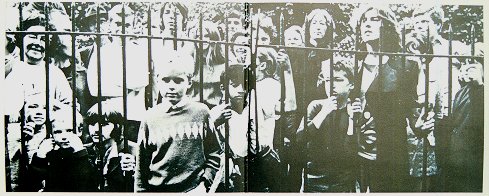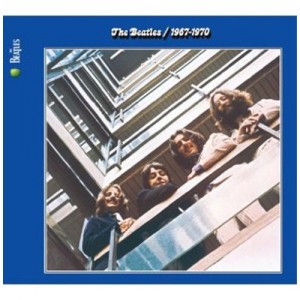It was forty-one years ago, today.
No, really. Check it out:
Let us not forget, it’s the “Blue Album”. Before it was the cassette, the eight-track, CD or digital download, it was a record, played on things called record players. And those records came inside of environmentally unfriendly covers that, for the most part, served the purpose later appropriated by magazines, music videos and online lyrics searches.
Talking about listening to music on antiquated machines probably sounds as old fashioned, today, as the idea of people watching silent movies with sub-titles did to kids like me, almost exactly 30 years ago. Of course, when I first put my impressionable paws on this artifact (a used copy procured from a classmate’s older brother who sold it to me for five bucks, a deal only slightly less spectacular, in my eyes, than the Louisiana Purchase), the Beatles had been broken up for less than ten years. Put another way, I got this album into my life at a time when many people still held out hope that the Fab Four might one day reunite. This quixotic fantasy got permanently put to rest when John Lennon was murdered in December of 1980.
Look at it. Even now, that cover shot is revelatory, poignant, perfect. That is the best band of all time at the very height of their superhuman powers (even if, unbeknownst to the outside world the group was already in the accelerated process of imploding). That image is a picture worth a thousand—or a million—words if ever there was one: a passage of time (artistically, creatively, personally) that covered epochs as opposed to years. Even a nine year old could see, clearly, how much had changed. The music bears this out, naturally, in ways that words and images can scarcely begin to convey.
Still, the fact that the mop-tops caused controversy in the early ‘60s (look at the back cover) indicates how much fashion, and the world, had changed by the late ‘60s (look at the front cover). At the beginning and toward the end, the Beatles did many things first and more often than not, they did them best. Even when things didn’t go according to plan, the stars always aligned in unbelievable ways for this band. Consider the cover: that picture was intended to be used for the work-in-progress called Get Back; by the time it was finally finished (and renamed Let It Be) another set of images were utilized. This had particular resonance for fans in the U.S., since the band’s first album Please Please Me was not released stateside until its reincarnation as a compact disc in 1987. Therefore, the cover image “borrowed” for the Red Album was always the proper choice, and it was oddly disappointing to discover the correct chronology. (In hindsight it would have been remarkable to have the same pose at the same location bookending the beginning and end of the Beatles’ career, but that’s what the Red and Blue albums were for!)
And, it should be pointed out that, strictly speaking, there is no Blue Album (or Red Album) just as there is no White Album: in fact, each of the releases is entitled The Beatles with the red one signifying the years 1962-1966 and the blue one 1967-1970. But these monikers had less to do with the album covers and more to do with the fact that the actual LPs were blue and red, respectively. And that, my friends, was about as cool as it got for burgeoning Beatles fanatics. Suffice it to say, we had a lot of time on our hands during those pre-MTV and Internet days.

Listen to it. The first thing you might notice is that it’s not a flawless selection of songs, all things considered. But therein lies the difficulty masterminding a compilation that dares to represent the Beatles. Everyone who hears this album will quickly point out songs inexplicably left off (“You Never Give Me Your Money”!) or ones improbably included (“Octopus’s Garden”?), but in the final analysis, the Blue Album (along with the Red Album) remains difficult to criticize. In terms of turning on casual fans to the myriad riches recorded at Abbey Road, these documents deliver the goods, and entice the intrigued to seek out the source material. Also, these albums first came out in 1973, so they were essentially the first official crack at a “greatest hits” type compilation. Covering the hits and the songs that were important and/or influential is the most reasonable way to go. Besides, part of being a fan is thinking up (and ceaselessly revising) your own selections of essential tracks.
1967-1970. That’s it. That’s all the time it took for the Beatles to not merely change music, but create art that remains, in many ways, incomparable. The ocean they crossed in between “I Want to Hold Your Hand” and “Tomorrow Never Knows” is difficult to describe; the universe they travelled from “Strawberry Fields Forever” to “Her Majesty” remains one of the creative miracles of the 20th Century. Taken as a single document presenting this evolution, the Blue Album is a holy grail of sorts.
The Beatles took a quantum leap with Rubber Soul (1965) and then doubled down with the sublime innovation of Revolver (1966). Quite simply, the biggest band in the world was recreating the world in its image and they were untouchable. And then Brian Wilson and the Beach Boys dropped Pet Sounds. Paul McCartney, steadily asserting himself as the group’s prime mover, was equal parts impressed and intimidated. Everyone knows what happened next. But before Sgt. Pepper helped define the Summer of Love and introduce the mixed blessing also known as the concept album, the Beatles released what is arguably the most transcendent single of all time.
Not only did “Strawberry Fields Forever/Penny Lane” signify (yet another) giant step for the band, it crystallized the principle strengths of its primary songwriters. Lennon agonized over the acoustic-based (!) snapshot of youth seen through the glass surreally that “Strawberry Fields Forever” mutated into (with considerable assistance from the ever-underrated George Martin). McCartney, as always, makes it sound easy. “Penny Lane”, while being neither as oblique nor unsettling as “Strawberry Fields Forever”, is disarmingly rich in detail and the product of a songwriter firing on all cylinders. In a move that reveals McCartney’s inspired and indefatigable mind, he asked George Martin to approximate the piccolo trumpet featured in a movement from Bach’s Brandenburg Concerto, granting his whimsical reminiscence an almost regal air.
That these two songs commence the proceedings is appropriate and symbolic. From there it’s an obligatory round-up of Sgt. Pepper highlights and tracks found on Magical Mystery Tour. Then, the three singles released prior to The White Album: McCartney’s delightful Fats Domino-inspired “Lady Madonna”, and the band’s blistering take on Lennon’s “Revolution” (which, of course, would resurface in mellow and riotous incarnations on the next album). And then there is that little song called “Hey Jude”. Taken in context, as merely another masterpiece, it is easier (and perhaps more intimidating) to consider how incredible the Beatles were circa 1968. “I Am the Walrus”, “Hello Goodbye”, “Hey Jude”, “Revolution”… just another day at the office.
Going forward, even as John and Paul’s working relationship grew increasingly strained, the two were always able to improve one another’s work. After a few relatively “safe” (or accessible) songs from The White Album there is another block of transitional singles. “Don’t Let Me Down”, which never made it onto Let It Be (but did make the cut for 2003’s Let It Be… Naked release) and “The Ballad of John and Yoko”, the group’s last number one single in the UK (two songs that were available only on the Blue Album or the Hey Jude singles collection until the 1987 release of the CD Past Masters Volume 2). Both of these songs are very personal compositions written entirely by Lennon, but they each feature significant contributions from McCartney. Mac’s harmonizing (and screeches toward the end) on “Don’t Let Me Down” manage to augment the urgency and elevate it to the level what amounts to a desperate celebration—or a celebratory desperation if you like. “The Ballad of John and Yoko” is a song that would be witty, hilarious and moving (i.e., a typical Lennon song), but is kicked up several notches thanks to McCartney’s contributions. In addition to harmony vocals and his usual bass duties, Mac turns in a more than respectable performance on drums, and his ebullient piano flourishes practically turn the song into the equivalent of a smile. That the two estranged superstars, in a flash of inspiration recorded a hit single (about Yoko Ono!) as a duo on a random afternoon is just one excellent example of what truly sets this band above and beyond.
Even the so-called “quiet Beatle” gets his props courtesy of four songs on sides three and four. Needless to say, this representation of George Harrison’s work echoes his escalating confidence as a composer (and subsequent frustration regarding his unshakable secondary status—another important factor that helped hasten the band’s inevitable dissolution). The rest of the album features familiar tracks from the final two albums (and since Let It Be was released after Abbey Road there is a certain symmetry in putting those songs last—and hearing the then-unreleased single versions of “Let It Be” and “Get Back” helps one appreciate the unsterilized versions even more). Then, all of a sudden, it’s 1970.
The Blue Album then, was never intended to supplant or steal thunder from the band’s amazing catalog. It was—and remains?—an ideal introduction to the most productive four-year span in pop music history. It is remembered—and appreciated—as a sacred relic from a less complicated time. Its front and back signify the before and after shots of ancient history and an unimaginable future. It is a reminder that the mysterious, magical tour might not have lasted forever, but the music will.
(For those arriving late to the party, a LOT more on the Beatles HERE, HERE, HERE, HERE, HERE, HERE, and HERE.)
